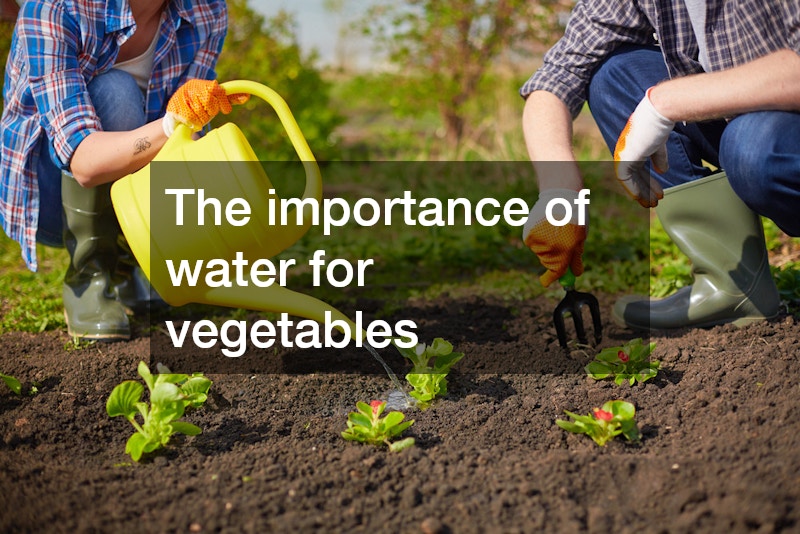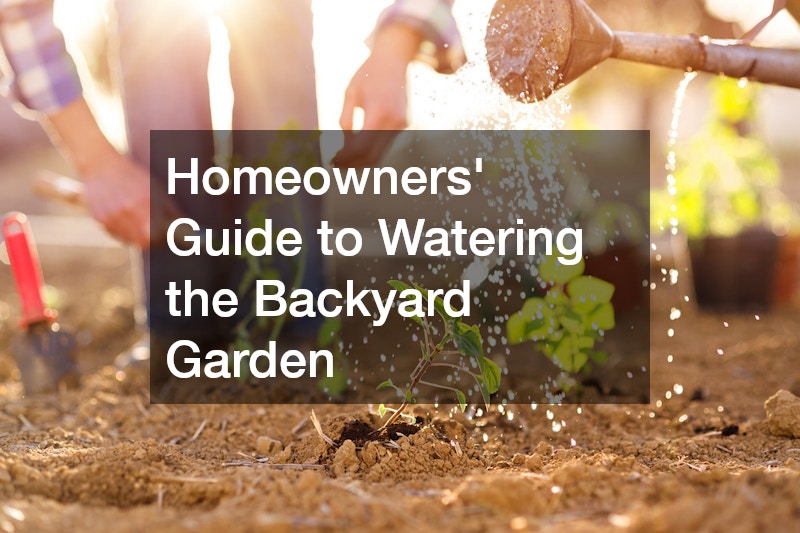Homeowners’ Guide to Watering the Backyard Garden
The purpose of a vegetable garden (also called a vegetable plot or vegetable patch) is to grow vegetables and other edibles. This garden is different from a flower bed, which is primarily used for decoration.
You must choose a location, prepare the soil, and select seeds and plants. Then, you need to plant and maintain them until harvest. This garden produces fresh produce that can be eaten, shared, or sold. Spend some time each day to care for your spring garden. Anyone can do it with modest investments of time, money, and skills that will improve over the years. Even if your first attempt fails, keep going.
For your garden to thrive, water is as important as soil and sunlight. Watering your garden can be a challenge. Many people don’t know how to water their vegetable gardens. Overwatering can lead to diseases and unhappy plants such as tomatoes and squash. Underwatering, on the other hand, can cause stunted vegetable growth like onions as well as a smaller harvest. It is important to properly water your garden to avoid any unnecessary problems during the growing season.
Why Do Vegetable Gardens Need Water?
Vegetables can be eaten in all parts of the plant, including roots, stems, and leaves. You can eat them raw or cooked as part of your meal or salad. Vegetables have been essential for international trade since ancient times. Although vegetables have a low food value due to their high water content, usually between 70 and 95 percent, they still provide a healthy addition to any diet.
It is important to keep young and newly planted seedlings healthy by watering them regularly. To avoid them drying out, water them lightly each morning and then check them again at night. Be careful not to let a crust of dry soil form on top, as this can hinder the growth of new seeds. A germination seed may not survive if it dries.
The importance of water for vegetables

Water is essential for plants to grow and survive. Water is essential for plants to survive and grow. It helps them transport nutrients from one part of the plant to another. Photosynthesis is a process that plants use to make food by using sunlight, CO2, and water. The process occurs through tiny openings on the leaves called stomas, which produce oxygen as a result.
To prevent overheating, plants use a process known as transpiration. The process of transpiration involves the evaporation of water from their leaves. As water evaporates off the leaves, more water is pulled through the roots. Water dissolves nutrients and sugars produced by photosynthesis and moves them from high-concentration areas, such as roots, to low-concentration areas, like blooms, stems, and leaves. This is important for growth and reproduction.
Structural Support
Turgor is a constant pressure applied to the cell walls of many plants that provides structural support. It makes them flexible and strong. They can bend with the wind and place their leaves to maximize photosynthesis. Plants that do not get enough water may have their leaves curl, and their tissues turn brown. This can lead to their death. Watering garden plants deeply and thoroughly is better than watering them frequently and lightly. This will encourage deeper root growth.
Best Time to Water Vegetable Garden Plants
Watering your garden in the morning is recommended for better results. It’s cooler, and there’s less water evaporation. Watering at the base may cause some water to splash onto the plants’ leaves, even if you water the plant. The leaves will have enough time to dry throughout the day if you water in the morning.
You can water your plants at night if you are too busy in the mornings with school and work. It’s a great option because it is cooler, and there is less water lost through evaporation. You should be careful not to get too much water onto the leaves, as they will not dry out overnight.
It is not advisable to water your plants during the mid-afternoon as this will waste a lot water through evaporation, and put a strain on your local water supply. It is best to water your garden early in the morning or late at night when it is cooler.
Watering plants in the morning
Watering your plants in the morning will help you save water, and also create a healthier atmosphere for them. This is a more efficient way to water plants and it works in almost all climates.
- Benefits: This product conserves and follows a plant-friendly watering schedule. It protects delicate leaves against sun damage.
- Disadvantages: Be careful when trying to increase the humidity, as this may create an environment that is suitable for pests such as spider mites. These thrive in soils that are evenly moist. Avoid overwatering and saturating soil that is already damp.
Watering plants in the evening
Watering plants at night has some benefits, but it is not recommended that you do this regularly. Watering plants at night can cause water to be wasted because you are saturating the soil when your garden is not in use.
Can dry soil be revived after a summer drought? It is possible. If the soil is well-drained, it can be revived, and plants cannot be drowned. The excess water will drain before dawn. You can warm the soil in spring by leaving buckets of water out in the sunlight during the day and then using warm water at night. You can plant earlier by using this technique.
Watering in the evening can cause soil to freeze, which will damage the roots. Evening watering in clay soils or soils that retain moisture can cause overwatering, fungus and other problems. Watering at night can also lead to water loss through drainage and runoff before plants are able to absorb the water in the morning.
Avoid watering your plants in the middle of the day since much water will evaporate. Watering plants more frequently is best done in the early morning to prevent them from drying out during the day. If you live in a hot climate, you might need to water plants twice daily – one in the morning and another at sunset.
How to determine the frequency of watering vegetable garden plants
Watering frequency varies based on several factors. This will ensure that the vegetables grow well in your patio garden. Watering depends on soil type, climate, and the type of vegetable you are growing.
Soil type and drainage considerations
Knowing the type of soil in your garden is essential for a clearer gardening routine. Sandier soils will need more watering because they drain better. Water seeps quickly out due to the larger particles. If your soil is denser and richer, then it will hold moisture longer. Add two to three inches of your plant’s compost or mulch. This will help them retain moisture. Increase the organic matter in your garden soil to help it retain moisture. Organic matter will help the soil retain moisture.
Plant Growth and Maturity Stage
How often you need to water your vegetables will depend on the type of vegetable that you are growing. Newly planted seedlings and young plants, for example, require more frequent irrigation than mature plants. The roots of young plants have not developed enough to reach deeper into the soil and absorb moisture. Vegetables in the flowering or fruiting stage require more water than vegetables in their vegetative stage.
Weather and Climate
The weather and climate can also affect how often you should water your garden.
Natural Rainfall: To hydrate your vegetables properly, you should provide between one and two inches of water per week. This includes both manual watering and rainfall. To plan properly, it’s important to keep an eye on the weather. You should pay attention to the weather when deciding how often you need to water your vegetable garden. Consider the weather conditions, including temperature and rainfall. Adjust your watering schedule accordingly. Watering may be required every two days during some weeks, but less frequent watering may be needed in rainier months. It’s important to be aware of the conditions as a gardener.
Checking the soil moisture using your hands is the easiest and most effective method to determine when you should water your plants. If you can feel moisture, it’s best to wait before watering. If the soil is completely dried, you should re-irrigate. Keep the plant from becoming saturated.
Water use can be affected by seasonal and weather factors such as rainfall, humidity, and temperature. Wind and sunshine hours are also important. Plants use more water in the summer when it is warm and less during winter when it is cooler. Water usage also increases in hot, sunny, and windy conditions.
Mulch has a high water retention capacity.
You can save money and time by conserving water in your garden. Use methods like mulching, drip-irrigation, drought-resistant plants, and water-retaining materials. Mulching helps reduce evaporation, suppresses the growth of weeds and retains moisture in soil.
Consider drip irrigation to conserve water in your yard. This method delivers water directly into the roots of plants, reducing evaporation. Planting drought-resistant varieties of plants can also reduce water consumption. By adding biochar or compost to your soil, you can improve soil fertility and increase water retention.
Effective Vegetable Garden Watering Tips

It is both eco-friendly, and practical to be mindful of the way you use water in your gardens. You can save money and time while benefiting your plants.
Water Stress in Plants: What to look for
Knowing the signs of plant water stress is important, as well as when to water them. If a plant is not getting enough water, signs will appear, such as browning tips, a dull appearance, and even the dropping of leaves. Plants will concentrate on their survival, and they may not produce new leaves or flowers. The leaves of the plant may not return if it is consistently underwatered. Watering intermittently will cause the leaves to go through a growing and dying cycle.
The best way to help the plant grow is to water in moderate quantities. You should not overwater your plant just because you are feeling bad. Maintain this level of watering on a regular basis. Water until the soil feels damp. Consider removing any buds or blossoms to encourage the plant’s energy to be focused on growth.
Use of a drip irrigation or soaker hoses to water efficiently
Water is conserved by using soaker hoses and drip irrigation systems. Drip irrigation uses a low pressure system to deliver water slowly and regularly directly to each plant’s roots. Soaker tubes are long tubes that have tiny holes and deliver water to the soil.
This irrigation system is a great option if you are looking for ideas on vertical gardens. This irrigation system can be used to water vertical plants, such as those hung on towers or arranged in a grid. It saves time and energy by hydrating the plants.
Water directly at the roots
It is crucial to water your plants in the root zone. Avoid watering the leaves of your plants as this may cause fungus and leaf disease. The best way to make sure water gets to your plants’ roots is with a drip irrigation system or soaker hose.
The roots will receive moisture through this method. The water is quickly absorbed by the roots and provides hydration to support healthy growth.
Deep and frequent watering to promote deep root growth
It is best to water your lawn less often but more deeply in order to ensure healthy growth. Light sprinkling can help establish roots in newly planted turf, but established turf needs deeper root growth. Light sprinkling can result in shallow roots, which will increase watering frequency. This can cause weeds and diseases to grow on the surface.
Water deeply and rarely to promote healthy roots, maximize water efficiency, and improve turfgrass. Allow water to penetrate 6-8 inches of soil. Some grasses may have shallower roots than others.
Mulching conserves soil moisture and reduces evaporation
Mulches can be used to reduce evaporation. There are many options, including landscape fabrics, stone-covering pots, and pebbles. The most effective mulches, however, are compost or other organic material that has been well-rotted. Mulches should be placed on moist soil at a thickness of around two inches (5 cm).
It is best to use bark chips as mulch, as they drain rainwater more efficiently. You can also use grass clippings for mulching. They are easily available. Keep the mulch fresh during the summer. This technique can be used when practicing container gardening.
Watering frequency can be adjusted based on the weather conditions
Watering frequency should be adjusted according to the weather. Reduce watering in cooler, wetter conditions and increase it during hot, dry weather. Watering close to the soil is also best for maximum efficiency. The use of drip irrigation systems is a great way to avoid misting, runoff, and overspray.
Monitoring soil moisture with a moisture tester or finger test
Monitor soil moisture to save water and time. You can do this using a moisture tester or by performing the finger test. The finger test is easy to do. Insert your index finger into the soil about 2 inches deep. If it feels dry, you should water it. If you have access to it, place a moisture meter near the root zone of the plant. A reading of between 5 and 10 indicates moisture, while one below 5 indicates dry soil.
Preventing waterlogging and root decay by avoiding overwatering
Waterlogging and root rot can be caused by overwatering. Overwatering can prevent oxygen from reaching the soil and suffocate plants. Your soil will not be able to absorb more water if it remains wet. This means that your plants won’t get the necessary hydration. Check the soil moisture level before watering. Only water when necessary.
Consider rainwater harvesting for sustainable watering
Consider reusing rainwater to water plants. This will reduce your water consumption and minimize runoff. Rainwater contains no contaminants or minerals and is, therefore, ideal for vegetable gardens. You can collect rainwater into a barrel or cistern and then use drip hoses that are gravity-fed to water your garden. You can also install an irrigation system that uses recycled water, like a bubbler or drip, to water your plants. You can save energy and time while also reducing your carbon footprint.
Maintaining irrigation equipment regularly and inspecting it for its proper working
It is essential to inspect and maintain your irrigation system regularly in order to ensure proper equipment and efficient irrigation. Checking the water pressure is one way to do this. Other ways include testing for leaks and cleaning filters. Once you are confident that everything is functioning properly, you can set up watering schedules and make adjustments as necessary.
Watering frequency will vary depending on your soil type, climate and the type of vegetables you are growing. It is crucial to monitor weather conditions and soil levels in order to adjust watering schedules accordingly. Consider implementing drip irrigation and mulching systems to further reduce water consumption. Maintain and inspect your irrigation system regularly to ensure that it is delivering water efficiently for a healthy vegetable garden.

